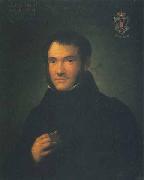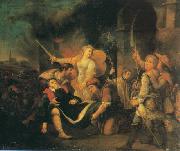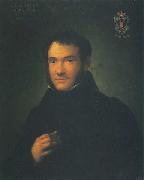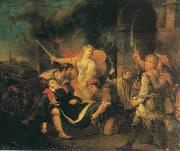Rafal Hadziewicz Oil Painting ReproductionAll Rafal Hadziewicz Oil Paintings(13 October 1803 - 7 September 1883) was a Polish historical painter. Born in Zamch, Hadziewicz attended art school from 1816 to 1822. In 1822 he studied at Warsaw University under Antoni Brodowski. After getting a scholarship he traveled to Dresden in 1829 and later to Paris, where he studied at a prominent French School of Painting. In 1831 he continued his studies in Rome. He stayed in Rome in 1833 for self-study of the masters. At this time he created many well-received sketches. In 1834 he went to Krakew and painted icons for several Orthodox churches there. In 1839 he left for Moscow, where he served in the Department of Fine Art and Mathematics until 1844. In 1844 he moved back to Warsaw, where he served as a professor in the Warsaw School of Art. In 1871, near the end of his life, he was transferred to a university in Kielce, where he died. Hadziewicz painted many religious paintings and portraits but was best known for historic compositions, which were often compared to art of the Italian Renaissance and European Baroque. |
|||

|
|||
|
|
|||
|
||||||||
| Rafal Hadziewicz (13 October 1803 - 7 September 1883) was a Polish historical painter. Born in Zamch, Hadziewicz attended art school from 1816 to 1822. In 1822 he studied at Warsaw University under Antoni Brodowski. After getting a scholarship he traveled to Dresden in 1829 and later to Paris, where he studied at a prominent French School of Painting. In 1831 he continued his studies in Rome. He stayed in Rome in 1833 for self-study of the masters. At this time he created many well-received sketches. In 1834 he went to Krakew and painted icons for several Orthodox churches there. In 1839 he left for Moscow, where he served in the Department of Fine Art and Mathematics until 1844. In 1844 he moved back to Warsaw, where he served as a professor in the Warsaw School of Art. In 1871, near the end of his life, he was transferred to a university in Kielce, where he died. Hadziewicz painted many religious paintings and portraits but was best known for historic compositions, which were often compared to art of the Italian Renaissance and European Baroque. |
||||||||
|
|
||||||||
| Gemälde IDENTIFIZIERUNG:: 74608 Portret Michala Wiszniewskiego oil, canvas, 74 x 59,5 cm. cjr |
||||||||
|
|
||||||||
| Gemälde IDENTIFIZIERUNG:: 76140 HadziewiczRafal olej, płetno, 37,7 x 46,6 cm. cyf |
||||||||
|
|
||||||||
| Gemälde IDENTIFIZIERUNG:: 76141 Wiszniewskiego Painter: Rafał Hadziewicz (1803-1883); Painting in collection: Lviv the picture gallery, Ukraine; Characteristics: oil, canvas, 74 x 59,5 cm. cyf |
||||||||
|
|
||||||||
| Gemälde IDENTIFIZIERUNG:: 96611 Smierc generala Henryka Kamienskiego pod Ostroleka oil on canvas Dimensions 37,7 x 46,6 cm cyf |
||||||||
|
|
||||||||
|
| VORHERIGER KÜNSTLER NÄCHSTER KÜNSTLER | |||||||
|
|
||||||||
|
Rafal Hadziewicz (13 October 1803 - 7 September 1883) was a Polish historical painter. Born in Zamch, Hadziewicz attended art school from 1816 to 1822. In 1822 he studied at Warsaw University under Antoni Brodowski. After getting a scholarship he traveled to Dresden in 1829 and later to Paris, where he studied at a prominent French School of Painting. In 1831 he continued his studies in Rome. He stayed in Rome in 1833 for self-study of the masters. At this time he created many well-received sketches. In 1834 he went to Krakew and painted icons for several Orthodox churches there. In 1839 he left for Moscow, where he served in the Department of Fine Art and Mathematics until 1844. In 1844 he moved back to Warsaw, where he served as a professor in the Warsaw School of Art. In 1871, near the end of his life, he was transferred to a university in Kielce, where he died. Hadziewicz painted many religious paintings and portraits but was best known for historic compositions, which were often compared to art of the Italian Renaissance and European Baroque. |
||||||||
|
|
||||||||
|
KONTAKTIEREN Sie UNS |









